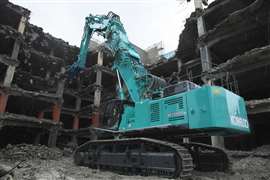Ireland urged to raise demo project tax to 23%
08 November 2023
The Chartered Institute of Building (CIOB) is calling for the Government of the Republic of Ireland to raise the level of VAT (value added tax) applied to demolition projects, urging them to increase the tax amount from 13% to 23% of the project value.
 (Photo: Kobelco)
(Photo: Kobelco)
The institute claims the country needs to drastically reduce the number of structures being demolished, in order to avoid constructing new buildings, which would results in the creation of yet more embodied carbon and carbon emissions.
It said that the current, lower rate of tax placed on demolition and dismantling activities is “creating a perverse environment where the embodied-carbon-hungry activities of demolition and replacement enjoy taxation parity with the sustainable repair and restoration”.
Joseph Kilroy, Policy and Public Affairs Manager for Ireland, Northern Ireland, Scotland and Wales at CIOB, said: “At a time when so many decisions are cost-based, it’s wrong that carbon-intensive options can be more financially beneficial than more sustainable options.
“With the construction and operating of buildings accounting for large proportions of Ireland’s and Northern Ireland’s carbon emissions, incentivising refurbishment and renovation needs to be a priority for both Governments in order to reach net zero by 2050.”
According to the CIOB, Ireland’s built environment accounts for 37% of its carbon emissions, with operational carbon from the heating, cooling and lighting of structures making up most of it.
Joseph added: “Charging full VAT for demolition in Ireland while maintaining the reduced rate for repair and refurbishment and introducing a levy for demolition in Northern Ireland would create tax environments that reflect the principles of existing climate legislation and the urgency of the national net zero by 2050 targets.”
In addition to the tax reform, the CIOB wants the Irish government to introduce a “demolition levy in Northern Ireland”, to generate additional revenue that it says “could be used to fund initiatives that support energy-efficient upgrades to housing, help vulnerable households cope with the cost-of-living crisis, and preserve historic buildings”.
The CIOB further states that the current lower tax rate enjoyed by Ireland’s demolition sector, “contradicts principles outlined in the Circular Economy and Miscellaneous Provisions Act 2022, the Climate Action and Low Carbon Development (Amendment) Act 2021, and the EU Taxonomy Regulation 2020”.
STAY CONNECTED


Receive the information you need when you need it through our world-leading magazines, newsletters and daily briefings.
CONNECT WITH THE TEAM











